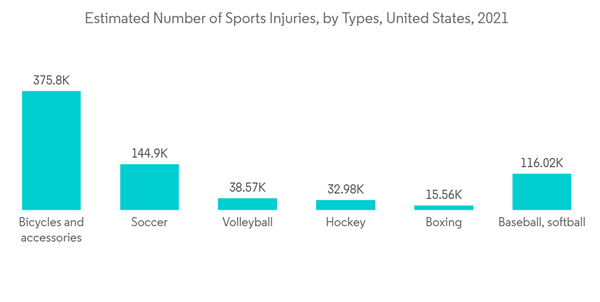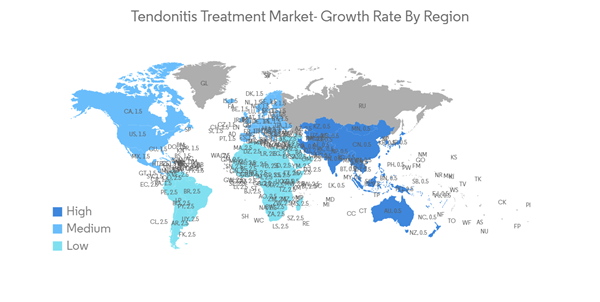The tendonitis treatment market is expected to register a CAGR of 3.57% during the forecast period.
The COVID-19 pandemic is an unprecedented health concern and significantly impacted the tendonitis treatment market worldwide. The shortage of healthcare professionals for treating tendonitis hampered the development and growth of the market during the COVID-19 pandemic. Besides, the cancellation of sports activities resulted in fewer sports injuries, thereby negatively impacting the tendonitis treatment market. In addition, according to a 2021 update by the National Safety Council (NSC) of America, the Consumer Product Safety Commission (CPSC) reported that during the first seven months of the COVID-19 pandemic, visits to emergency departments for consumer product-related injuries fell by 24%. The largest decrease occurred in April, with a 45% decrease. Over the full year, consumer product injuries treated in emergency departments decreased by 18% in 2020 compared to 2019. The highest decrease in injuries was sports-related injuries associated with track and field. However, since the lockdown restrictions were lifted, the industry has been recovering well. Following the record low number of consumer product-related injuries reported in 2020, injuries increased by 6.8% in 2021.
The factors that are fueling the market include the rising burden of sports injuries and the consistent innovation of new products and treatment modalities. The National Safety Council (NSC) reports that in 2021, injuries caused by exercise equipment accounted for nearly 409,000 of all sports and recreation-related injuries. In addition, bicycles and accessories accounted for 375,797 injuries in the year 2021 in the United States. Thus, a significant number of sports-related injuries may increase tendonitis leading to rising demand for its treatment, thereby fueling the growth of the studied market.
Moreover, the increasing efforts undertaken by major market players to develop technologically advanced products may contribute to the tendonitis treatment market’s growth. For instance, in September 2021, Ossur, a global innovator in prosthetic and non-invasive orthopedic technologies, launched the new Rebound Post-Op Elbow Brace, a non-invasive, lightweight, adjustable brace designed to provide elbow immobilization and range-of-motion restrictions for patients with a variety of conditions, including chronic elbow injuries and tennis elbow release. Additionally, in April 2021, MiMedx Group announced that the last patients in two late-stage Investigational New Drug (IND) trials had completed their previous clinical visits: Phase 3 studies of AmnioFix Injectable (micronized dehydrated Human Amnion Chorion Membrane (mdHACM)) as a potential treatment for Plantar Fasciitis and Achilles Tendonitis.
A lack of awareness about the condition and its advanced treatments among the population may negatively affect the market.
According to a study published in the World Journal of Orthopedics in April 2022, lateral epicondylitis (LE), also known as tennis elbow, is a reasonably frequent ailment that affects 1%-3% of the population each year. Approximately 4-7/1000 persons consult their general practitioner owing to LE symptoms. It is anticipated that roughly 40% of all persons may experience LE symptoms at some point in their lives. The significant burden of tennis elbow may propel the demand for its treatment, thereby boosting the segment's growth. Additionally, according to an article published by the National Library of Medicine in July 2021, the disease is more common in individuals aged older than 40 years.
Tennis elbows are treated using various methods, including physical therapy, surgery and other treatments such as hyaluronic acid. For instance, according to a study published in BMC Journal in January 2022, hyaluronic acid (HA) injections provided significant pain relief for patients with chronic TE. This study suggested that patients with chronic lateral epicondylitis may benefit from hyaluronic acid injections rather than undergoing a surgery.
According to data from the National Safety Council (NSC) updated in 2022, about 115,790 swimming injuries were treated in emergency rooms in 2021, with children under 14 years suffering half of all injuries. In addition, in 2021, 3.2 million people were treated in emergency departments for injuries involving sports and recreational equipment, and the activities frequently associated with injuries are exercise, cycling, and basketball. Thus, a significant number of sports injuries may increase the tendonitis condition, increasing the demand for its treatment and boosting the market.
As per a study published in March 2021 in the World Journal of Orthopedics, about 1 in 10 patients suffering from tennis elbow conditions with persistent symptoms for more than six months required surgery in the United States. However, around 8.5% of patients complained about the recurrence of the condition within two years.
This product will be delivered within 2 business days.
The COVID-19 pandemic is an unprecedented health concern and significantly impacted the tendonitis treatment market worldwide. The shortage of healthcare professionals for treating tendonitis hampered the development and growth of the market during the COVID-19 pandemic. Besides, the cancellation of sports activities resulted in fewer sports injuries, thereby negatively impacting the tendonitis treatment market. In addition, according to a 2021 update by the National Safety Council (NSC) of America, the Consumer Product Safety Commission (CPSC) reported that during the first seven months of the COVID-19 pandemic, visits to emergency departments for consumer product-related injuries fell by 24%. The largest decrease occurred in April, with a 45% decrease. Over the full year, consumer product injuries treated in emergency departments decreased by 18% in 2020 compared to 2019. The highest decrease in injuries was sports-related injuries associated with track and field. However, since the lockdown restrictions were lifted, the industry has been recovering well. Following the record low number of consumer product-related injuries reported in 2020, injuries increased by 6.8% in 2021.
The factors that are fueling the market include the rising burden of sports injuries and the consistent innovation of new products and treatment modalities. The National Safety Council (NSC) reports that in 2021, injuries caused by exercise equipment accounted for nearly 409,000 of all sports and recreation-related injuries. In addition, bicycles and accessories accounted for 375,797 injuries in the year 2021 in the United States. Thus, a significant number of sports-related injuries may increase tendonitis leading to rising demand for its treatment, thereby fueling the growth of the studied market.
Moreover, the increasing efforts undertaken by major market players to develop technologically advanced products may contribute to the tendonitis treatment market’s growth. For instance, in September 2021, Ossur, a global innovator in prosthetic and non-invasive orthopedic technologies, launched the new Rebound Post-Op Elbow Brace, a non-invasive, lightweight, adjustable brace designed to provide elbow immobilization and range-of-motion restrictions for patients with a variety of conditions, including chronic elbow injuries and tennis elbow release. Additionally, in April 2021, MiMedx Group announced that the last patients in two late-stage Investigational New Drug (IND) trials had completed their previous clinical visits: Phase 3 studies of AmnioFix Injectable (micronized dehydrated Human Amnion Chorion Membrane (mdHACM)) as a potential treatment for Plantar Fasciitis and Achilles Tendonitis.
A lack of awareness about the condition and its advanced treatments among the population may negatively affect the market.
Tendonitis Treatment Market Trends
Tennis Elbow is Expected to Hold Significant Share in the Studied Market Over the Forecast period.
The tennis elbow segment will likely record a significant growth rate during the forecast period. New product launches and the availability of cost-effective treatment options are the major growth factors for the growth of the tennis elbow segment.According to a study published in the World Journal of Orthopedics in April 2022, lateral epicondylitis (LE), also known as tennis elbow, is a reasonably frequent ailment that affects 1%-3% of the population each year. Approximately 4-7/1000 persons consult their general practitioner owing to LE symptoms. It is anticipated that roughly 40% of all persons may experience LE symptoms at some point in their lives. The significant burden of tennis elbow may propel the demand for its treatment, thereby boosting the segment's growth. Additionally, according to an article published by the National Library of Medicine in July 2021, the disease is more common in individuals aged older than 40 years.
Tennis elbows are treated using various methods, including physical therapy, surgery and other treatments such as hyaluronic acid. For instance, according to a study published in BMC Journal in January 2022, hyaluronic acid (HA) injections provided significant pain relief for patients with chronic TE. This study suggested that patients with chronic lateral epicondylitis may benefit from hyaluronic acid injections rather than undergoing a surgery.
North America is Expected to Hold a Significant Market Share Over the Forecast Period
The tendonitis treatment market in North America is expected to dominate the global market due to the presence of major players and higher expenditure on advancements in healthcare. Awareness among people about tendonitis is growing more in North America compared to other regions. Due to well-established healthcare facilities, the increasing geriatric population, and the growing number of orthopedic procedures, North America is likely to dominate the overall tendonitis treatment market.According to data from the National Safety Council (NSC) updated in 2022, about 115,790 swimming injuries were treated in emergency rooms in 2021, with children under 14 years suffering half of all injuries. In addition, in 2021, 3.2 million people were treated in emergency departments for injuries involving sports and recreational equipment, and the activities frequently associated with injuries are exercise, cycling, and basketball. Thus, a significant number of sports injuries may increase the tendonitis condition, increasing the demand for its treatment and boosting the market.
As per a study published in March 2021 in the World Journal of Orthopedics, about 1 in 10 patients suffering from tennis elbow conditions with persistent symptoms for more than six months required surgery in the United States. However, around 8.5% of patients complained about the recurrence of the condition within two years.
Tendonitis Treatment Market Competitor Analysis
The tendonitis treatment market is consolidated. The major players in the market are engaged in product development and strategic alliances to cater to the growing global demand and gain a strong position in the market. Major companies profiled in the market report include Teikoku Pharma USA Inc., DJO Global Inc., Zimmer Biomet, 3M, and AKSIGEN.Additional benefits of purchasing the report:
- The market estimate (ME) sheet in Excel format
- 3 months of analyst support
This product will be delivered within 2 business days.
Table of Contents
1 INTRODUCTION
4 MARKET DYNAMICS
5 MARKET SEGMENTATION
6 COMPETITIVE LANDSCAPE
Companies Mentioned (Partial List)
A selection of companies mentioned in this report includes, but is not limited to:
- Colfax Corporation (DJO Global Inc.)
- Teikoku Pharma USA Inc.
- Zimmer Biomet
- 3M
- AKSIGEN
- Smith+Nephew
- Stryker
- Ossur
- Tynor India
- Merck and Co., Inc.
- Almatica Pharma, Inc.
- Teva Pharmaceuticals Industries
Methodology

LOADING...










